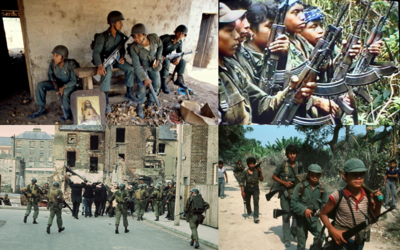San Carlos Islands Crisis
| San Carlos Islands Crisis | |||||||
|---|---|---|---|---|---|---|---|
| Part of the Creeperian Conflicts | |||||||
 Clockwise from top left: Creeperian Army soldiers in 2013, MRKA rebels in 1985, FAR-NS child soldiers in 2017, aftermath of a Frente NEPOC bombing in Cámarillo in 1991. | |||||||
| |||||||
| Belligerents | |||||||
|
Military support: Financial support: Diplomatic support: |
Military support: | ||||||
|
Military support: Template:Country data Lyoa Financial support: Diplomatic support: | |||||||
| Commanders and leaders | |||||||
|
|
| ||||||
| Units involved | |||||||
|
25th Air Force Wing 19th Flotilla Żelazo Brigade Naval Group 2 | Various militia groups | ||||||
| Strength | |||||||
|
46,000
|
MRKA: ~4,000
Frente NEPOC: 1,500 MRKA: 500–750
| ||||||
| Casualties and losses | |||||||
|
345 killed 590 injured |
1,500+ killed 500? injured 344 arrested | ||||||
| 1,122 civilians killed, 1,433 injured | |||||||
The San Carlos Islands Crisis (Creeperian Spanish – Iberic: Crisis de las'Islas San Carlos; Creeperian Spanish – Creeperian Ծրիսիս դե լաս'Իսլաս Սան Ծարլոս) is an ongoing armed conflict between the Creeperian government of the San Carlos Islands and various far-left, non-partisan, and far-right separatist groups. The conflict is the only ongoing conflict in Ostlandet and it is a part of the Creeperian Conflicts.
The conflict began on 12 October 1981, the symbolic 600th anniversary of the landing of Creeperian Admiral and explorer Cristóbal Colón Cámarillo on Norental, when the Juan Horacio Palafox Mendoza Revolutionary Council (CR-JHPM) was formed and declared their movement for the independence of the San Carlos Islands. The CR-JHPM was a non-partisan coalition of separatist groups and consisted of the Orisla Liberation Commandos (CLO), 12 October Movement (M–12–O), and the San Carlosan Independence Movement (MISC). Later in 1981, the far-left Kapahu Alana Revolutionary Movement (MRKA) was formed in Esclaveta and declared independence for the island and the Natives of the island, and in 1982, the far-right Norental-Esclaveta-Pescante-Orisla-Colón Front (Frente NEPOC) was formed and declared independence for all of the San Carlos Islands and had declared the superiority of the Creeperian race over the islands' Natives. Frente NEPOC was isolated to the island of Cámarillo and conducted urban terrorist attacks, while the CR-JHPM and MRKA were located in the remaining islands and committed mostly guerrilla attacks. Frente NEPOC ceased operations in 1994 after increased Creeperian Army operations against Frente NEPOC activities while the CR-JHPM and MRKA came to an agreement in the Ankarabad Accords on 13 March 1995.
A resurgence of war began on 17 August 2003 when the MRKA remobilized in the wake of the 2003 Creeperian coup d'état and the establishment of the Romerist Military Junta, which they believed would reject the 1995 Ankarabad Accords and restart the war. The Romerist Military Junta subsequently did denounce the parts of the accords which dealt with Esclaveta on 19 August 2003. Since then, the conflict has been a low-level insurgency with a guerrilla attack occurring on Esclaveta around 4 to 5 times per year. During the low-level insurgency, two new groups formed, the Native Revolutionary Armed Forces of the South (FAR-NS) in 2004, which continues to operate, and the Native Revolutionary Armed Forces of Pescante (FAR-NP) in 2007, which later ceased operations in 2010. FAR-NP was an affiliate of the MRKA throughout its existence and FAR-NS continued to affiliate with the MRKA.





